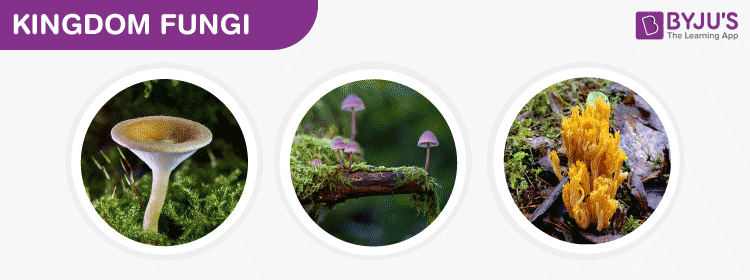Which Of The Following Traits Are Found In Both Fungi And Animals?
Table of Contents
- What is Fungi?
- Structure of Fungi
- Characteristics of Fungi
- Classification of Fungi
- Reproduction in Fungi
- Uses of Fungi
- Examples of Fungi

What is Fungi?
Fungi are eukaryotic organisms that include microorganisms such as yeasts, moulds and mushrooms. These organisms are classified nether kingdom fungi.
The organisms found in Kingdom fungi contain a jail cell wall and are omnipresent. They are classified as heterotrophs amidst the living organisms.

Kingdom Fungi
To proper noun a few – the appearance of blackness spots on bread left outside for some days, the mushrooms and the yeast cells, which are commonly used for the production of beer and breadstuff are also fungi. They are also institute in most pare infections and other fungal diseases.
If we observe advisedly, all the examples that we cited involve moist conditions. Thus, we can say that fungi usually abound in places which are moist and warm enough to support them.
Let us accept a detailed overview of the structure, nomenclature and characteristics of fungi.
Also Read:Kingdom Animalia
Construction of Fungi

The structure of fungi can be explained in the following points:
- Almost all the fungi have a filamentous structure except the yeast cells.
- They can be either unmarried-celled or multicellular organisms.
- Fungi consist of long thread-like structures known equally hyphae. These hyphae together form a mesh-like structure called mycelium.
- Fungi possess a prison cell wall which is made upwards of chitin and polysaccharides.
- The cell wall comprises a protoplast, which is differentiated into other cell parts such as prison cell membrane, cytoplasm, cell organelles and nuclei.
- The nucleus is dense, clear, with chromatin threads. The nucleus is surrounded by a nuclear membrane.
Too Refer: Fungal Cell Wall
Characteristics of Fungi
Following are the of import characteristics of fungi:
- Fungi are eukaryotic, non-vascular, non-motile and heterotrophic organisms.
- They may be unicellular or filamentous.
- They reproduce past means of spores.
- Fungi exhibit the miracle of alternation of generation.
- Fungi lack chlorophyll and hence cannot perform photosynthesis.
- Fungi store their food in the course of starch.
- Biosynthesis of chitin occurs in fungi.
- The nuclei of the fungi are very modest.
- The fungi take no embryonic stage. They develop from the spores.
- The mode of reproduction is sexual or asexual.
- Some fungi are parasitic and can infect the host.
- Fungi produce a chemical called pheromone which leads to sexual reproduction in fungi.
- Examples include mushrooms, moulds and yeast.
As well Read:5 Kingdom Nomenclature
Classification of Fungi
Kingdom Fungi are classified based on different modes. The different nomenclature of fungi is as follows:
Based on Manner of nutrition
On the ground of nutrition, kingdom fungi can be classified into 3 groups.
- Saprophytic – The fungi obtain their nutrition by feeding on dead organic substances. Examples: Rhizopus, Penicillium and Aspergillus.
- Parasitic – The fungi obtain their nutrition by living on other living organisms (plants or animals) and absorb nutrients from their host. Examples: Taphrina and Puccinia.
- Symbiotic – These fungi live byhavinganinterdependent relationship with other species in which both are mutually benefited. Examples: Lichens and mycorrhiza. Lichens are the symbiotic association between algae and fungi. Here both algae and fungi are mutually benefited as fungi provide shelter for algae and in opposite algae synthesis carbohydrates for fungi. Mycorrhiza is the symbiotic association present between fungi and plants. Fungi amend nutrient uptake past plants, whereas, plants provides organic molecules like sugar to the fungus.
Based on Spore Formation
Kingdom Fungi are classified into the following based on the formation of spores:
- Zygomycetes – These are formed by the fusion of two different cells. The sexual spores are known equally zygospores, while the asexual spores are known as sporangiospores. The hyphae are without the septa. Example – Mucor.
- Ascomycetes – They are also called sac fungi. They can exist coprophilous, decomposers, parasitic or saprophytic. The sexual spores are called ascospores. Asexual reproduction occurs past conidiospores. Instance – Saccharomyces.
- Basidiomycetes – Mushrooms are the nigh commonly establish basidiomycetes and mostly alive equally parasites. Sexual reproduction occurs past basidiospores. Asexual reproduction occurs past conidia, budding or fragmentation. Case- Agaricus.
- Deuteromycetes – They are otherwise called imperfect fungi as they do non follow the regular reproduction cycle as the other fungi. They practise not reproduce sexually. Asexual reproduction occurs by conidia. Example – Trichoderma.
Likewise Read: Difference Between Algae And Fungi
Reproduction in Fungi

Reproduction in Fungi
Reproduction in fungi is both by sexual and asexual means. The sexual fashion of reproduction is referred to every bit teleomorph and the asexual manner of reproduction is referred to every bit anamorph.
Vegetative reproduction –This takes place by budding, fission and fragmentation.
Asexual reproduction – This takes place with the help of spores chosen conidia or zoospores, or sporangiospores.
Sexual reproduction – This occurs by ascospores, basidiospores, and oospores.
The conventional way of sexual reproduction is not always observed in the kingdom Fungi. In some fungi, the fusion of ii haploid hyphae does not event in the formation of a diploid cell. In such cases, at that place appears an intermediate phase called the dikaryophase. This stage is followed by the formation of diploid cells.
Also Read:Kingdom Monera, Protista and Fungi
Recommended Video:

Uses of Fungi
Fungi are one of the virtually of import groups of organisms on the planet equally they play a vital role in the biosphere and have great economic importance on account of both their benefits and harmful furnishings.
Post-obit are some of the important uses of fungi:
- Recycling– They play a major office in recycling the expressionless and decayed thing.
- Nutrient– The mushrooms species which are cultured are edible and are used as food by humans.
- Medicines– There are many fungi that are used to produce antibiotics and to control diseases in humans and animals. Penicillin antibody is derived from a mutual fungus chosen Penicillium.
- Biocontrol Agents – Fungi are involved in exploiting insects, other small worms and assistance in controlling pests. Spores of fungi are used as a spray on crops.
- Food spoilage – Fungi play a major office in recycling organic textile and are also responsible for major spoilage and economic losses of stored food.
Examples of Fungi
Following are the common examples of fungi:
- Yeast
- Mushrooms
- Moulds
- Truffles
Likewise Read:Plant Kingdom
To know more than about what is fungi, its structure, characteristics of fungi, classification of fungi, different examples of fungi and other concepts related to kingdom fungi, keep visiting BYJU'S website or download the BYJU'S app for further reference.
Oft Asked Questions on Fungi
Which organisms belong to kingdom fungi?
Kingdom fungi include mushrooms, yeast and moulds containing filamentous structures called hyphae.
What are the different types of fungi?
The dissimilar types of fungi include- Zygomycetes, Basidiomycetes, Ascomycetes, and Deuteromycetes.
Which kingdom is closely related to kingdom fungi?
Kingdom fungi are closely related to the animal kingdom. This has been determined by phylogenetic studies. The phylogenetic tree explains how animals diverged from fungi millions of years agone.
What is common between plants and fungi?
Both plants and fungi have a jail cell wall.
Which course of kingdom fungi can movement?
Chytridiomycota produces flagellated gametes and is the simply exception to the grouping that can motility with the help of flagella. These are ancient fungi and are believed to be a connecting link between fungi and animals.
Source: https://byjus.com/biology/kingdom-fungi/
Posted by: stokesfrighters.blogspot.com

0 Response to "Which Of The Following Traits Are Found In Both Fungi And Animals?"
Post a Comment